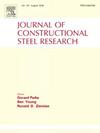Q355钢全范围应变相关动态增加因子(DIF)模型
IF 4
2区 工程技术
Q1 CONSTRUCTION & BUILDING TECHNOLOGY
引用次数: 0
摘要
结构材料在高速冲击和爆炸作用下具有高应变率,其本构行为因应变率效应而发生显著变化。这种影响已经被发现依赖于应变,例如,屈服应力的动态增加因子(DIF)通常高于抗拉强度。然而,对应变速率效应对应变的依赖关系的系统研究尚不充分,其微观机制尚不清楚。在这项研究中,设计和测试了一系列Q355拉伸片,片的尺寸和加载方案专门设计为实现五个接近恒定的真应变率(范围为0.001 s‐1 - 4460 s‐1)。确定了所有应变率对应的真应力-应变关系,得到了全量程DIF曲线。观察到显著的应变速率诱导强化效应,随着应变的增大,该效应逐渐减弱。根据实验结果,提出了一种新的全范围菌株依赖的DIF模型。该模型在预测各种结构金属在不同应变率下的全范围动态响应方面表现出一贯的高性能,与传统模型(例如C-S和J-C模型)相比,预测精度提高了24% ~ 62%。对三种不同应变速率下的试样试样进行了显微组织表征,并在每一试样试样上检测了不同应变对应的四个位置。位错增殖、晶粒细化和晶体取向演化的综合影响很好地阐述了应变速率效应对应变的宏观依赖关系。本文章由计算机程序翻译,如有差异,请以英文原文为准。

Full-range strain-dependent dynamic increase factor (DIF) model for Q355 steel
Structural materials experience high strain rates when subjected to high-speed impact and explosion, and their constitutive behaviour changes significantly due to strain rate effect. This effect has already been found to be dependent on strain, e.g., the dynamic increase factor (DIF) on yield stress is typically higher than that on tensile strength. However, systematic investigations on the dependence of strain rate effect on strain are inadequate, and the underlying microscopic mechanisms are still unclear. In this study, a series of Q355 tensile coupons was designed and tested, with the coupon dimensions and loading schemes specifically designed to achieve five near-constant true strain rates (ranging 0.001 s‐1– 4460 s‐1). True stress-strain relationships corresponding to all strain rates were determined and full-range DIF curves were then obtained. Significant strain rate-induced strengthening effect was observed, and the effect became less prominent with the increase in strain. Based on the experimental findings, a new full-range strain-dependent DIF model was accordingly proposed. The proposed model exhibits consistently high performance in predicting the full-range dynamic response of various structural metals under different strain rates, achieving a 24 % ∼ 62 % increase in predictive accuracy compared to traditional models (e.g. the C-S and J-C models). Microstructural characterizations were conducted on three post-test coupons subjected to different strain rates, and on each coupon, four locations corresponding to distinct strains were examined. Combinative influences of dislocation multiplication, grain refinement and crystal orientation evolution well elaborate the macroscopic dependence of strain rate effect on strain.
求助全文
通过发布文献求助,成功后即可免费获取论文全文。
去求助
来源期刊

Journal of Constructional Steel Research
工程技术-工程:土木
CiteScore
7.90
自引率
19.50%
发文量
550
审稿时长
46 days
期刊介绍:
The Journal of Constructional Steel Research provides an international forum for the presentation and discussion of the latest developments in structural steel research and their applications. It is aimed not only at researchers but also at those likely to be most affected by research results, i.e. designers and fabricators. Original papers of a high standard dealing with all aspects of steel research including theoretical and experimental research on elements, assemblages, connection and material properties are considered for publication.
 求助内容:
求助内容: 应助结果提醒方式:
应助结果提醒方式:


